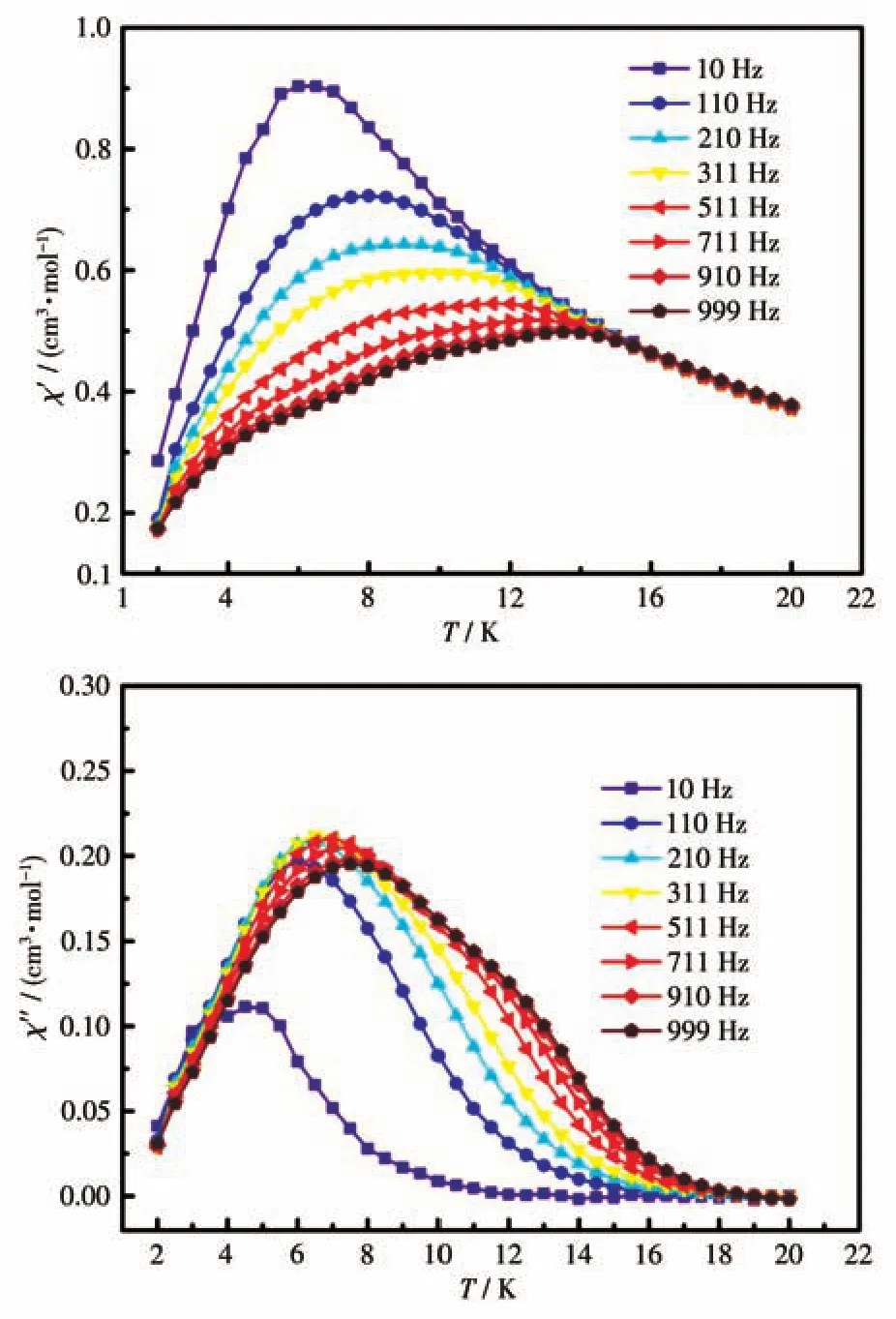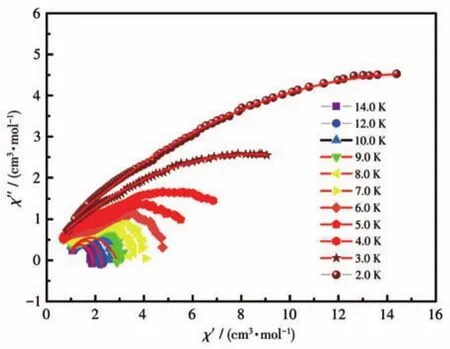A Dy2Complex Showing Outstanding Single-Molecule Magnet Behavior
XIN Xiao-YanZHANG Xue-JinCHEN Feng-Jiao WANG YuYANG ChenQIAO NaSHI YingWANG Wen-Min*,,2
(1Department of Chemistry,Taiyuan Normal University,Jinzhong,Shanxi 030619,China)
(2Institute for Carbon Neutrality,Taiyuan Normal University,Jinzhong,Shanxi 030619,China)
Abstract:Two new binuclear Ln(Ⅲ)-based complexes with the formula[Ln2(dbm)2(L)2(C2H5OH)2](Ln=Dy(1),Nd(2);dbm-=1,3-dioxo-1,3-diphenylpropan-2-ide)have been synthesized via the solvothermal method by using a polydentate Schiff base ligand(H2L=(E)-N′-(3-ethoxy-2-hydroxybenzylidene)-3-hydroxypicolinohydrazide)reacting with Ln(dbm)3·2H2O.Single-crystal X-ray structures reveal that complexes 1 and 2 are mainly composed of two Ln(Ⅲ)ions,two dbm-ions,two L2-ions,and two C2H5OH molecules,and the two central Ln(Ⅲ)ions are connected by two μ2-O atoms forming a“parallelogram-shaped”Ln2O2core.Magnetic studies show that the ferromagnetic interaction exists between the adjacent two Dy(Ⅲ)ions and single-molecule magnet behavior occurs in 1.CCDC:2100188,1;2133336,2.
Keywords:rare-earth-based complexes;crystal structures;magnetic properties;ferromagnetic interaction;single-molecule magnet
In recent years,a large number of Ln(Ⅲ)-based complexes have been synthesized and used in the study of single-molecule magnets(SMMs),including binuclear[1],trinuclear[2],tetranuclear[3],pentanuclear[4],hexanuclear[5],heptanuclear[6],and octanuclear[7]Dy(Ⅲ)-based complexes SMMs.Because the low nuclear complexes are easy to design and synthesize,the magnetic moment is easier to be an axial,and relatively large number of low nuclear Dy(Ⅲ)-based complexes showing SMMs behaviors have been reported[8-10].Binuclear Dy(Ⅲ)-based SMMs are an important model system,which can be used to answer whether the relaxation of the system comes from the relaxation of a single ion or the whole molecule[11].Therefore,a large number of binuclear Dy(Ⅲ)-based SMMs have been reported[12-14].In 2011,Tang group prepared an asymmetric Dy(Ⅲ)binuclear complex[Dy2(ovph)2Cl2(MeOH)3][15].Through experimental tests and theoretical calculations,it is found that there is a ferromagnetic coupling between Dy(Ⅲ)in this complex.Feng group[16]reported a series of binuclear lanthanide complex,[Dy2(Mq)4(NO3)6](Mq=2-methyl-8-hydroxyquinoline),which has exhibited SMM behavior.These binuclear Dy(Ⅲ)-based SMMs studies help to promote and stimulate the development of Ln(Ⅲ)-based single molecular magnetic materials and attract more inorganic chemists and materials scientists to design and construct Dy(Ⅲ)-based SMMs.
Based on the above considerations,in this work,we try to find an efficient synthetic strategy for constructing two new Ln(Ⅲ)-based complexes showing remarkable magnetic behaviors.As shown in Scheme 1,a multidentate Schiff-base ligand H2L(H2L=(E)-N′-(3-ethoxy-2-hydroxybenzylidene)-3-hydroxypicolinohydrazide)with abundant coordination atoms and multiple coordination modes has been used to synthesize Ln(Ⅲ)-based binuclear complex.To further explore and study the relationship between the structure and magnetic properties of binuclear Ln(Ⅲ)-based complex,we designed and synthesized two new binuclear Ln(Ⅲ)-based complexes with the formula [Ln2(dbm)2(L)2(C2H5OH)2](Ln=Dy(1),Nd(2);dbm-=1,3-dioxo-1,3-diphenylpropan-2-ide)via the solvothermal method by using H2L and Ln(dbm)3·2H2O.Structural analysis reveals that two central Ln(Ⅲ)ions are connected by twoμ2-O atoms forming a“parallelogram-shaped”Ln2O2core.Magnetic analysis shows that the ferromagnetic interaction exists between the adjacent two Dy(Ⅲ)ions and 1 has SMM behavior.

Scheme 1 Structure of H2L
1 Experimental
1.1 Materials and measurements
1,3-Diphenyl-1,3-propanedione,3-ethoxysalicylaldehyde,3-hydroxy-2-picolinyl hydrazide,and Ln(NO3)3·6H2O(Ln=Dy,Nd)were bought from Energy Chemical Co.,Ltd.,and the common solvents(ethanol,acetonitrile,and dichloromethane)were purchased from Komeo Reagent Co.,Ltd.According to the previously reported method[17],the multidentate Schiff base ligand H2L was synthesized.Ln(dbm)3·2H2O was prepared according to the method reported in the literature[18].
Elemental analyses for complexes 1 and 2 were performed on a Perkin-Elmer 2400 analyzer.Infrared spectra data were measured with a Bruker TENOR 27 spectrophotometer.Powder X-ray diffraction(PXRD)data were collected using a Rigaku Ultima Ⅳ instrument with CuKαradiation(λ=0.154 056 nm)in a 2θrange from 5°to 50°.The operating voltage and current were 40 kV and 25 mA,respectively.Thermogravimetric analysis(TGA)data were recorded using a NETZSCHTG 409 PC thermal analyzer.The magnetic measurements were performed through a Quantum Design MPMS-XL7 and aPPMS-9ACMS magnetometer.
1.2 Preparations of H2L and complexes 1 and 2
1.2.1 Synthesis of H2L
To a suspension of 3-ethoxysalicylaldehyde(20.0 mmol,3.32 g)in 10 mL methanol was added 3-hydroxy-2-picolinyl hydrazide(20.0 mmol,3.08 g).The resulting reaction mixture was stirred at room temperature for 4 h.The white precipitate was collected by filtration and washed with methanol.The crude product was dried under vacuum for 48 h to give the ligand(H2L)(Scheme 2).Yield:3.99 g(63%).Elemental analysis Calcd.for C16H19N3O4(%):C,60.50;H,5.90;N,13.23.Found(%):C,60.55;H,5.93;N,13.24.IR(KBr,cm-1):3 291(m),2 980(w),2 929(w),2 875(w),2 834(w),1 660(s),1 623(m),1 577(m),1 532(m),1 451(s),1 388(w),1 330(w),1 267(w),1 246(s),1 172(w),1 089(w),1 077(m),1 116(w),1 010(w),950(w),967(m),900(m),833(m),802(m),783(m),741(s).

Scheme 2 Synthesis of H2L
1.2.2 Synthesis of complexes 1 and 2
The synthesis method of complexes 1 and 2 was similar.Ln(dbm)3·2H2O(0.025 mmol,0.021 g)was added to a solution of H2L(0.025 mmol,0.008 g)in 15 mL of CH3OH/CH2Cl2/CH3CN(3∶1∶1,V/V),and then the mixture was stirred for 30 min at room temperature.Whereafter,the mixture was sealed and packed in a glass sample vase(20 mL),which was heated at 80℃for 24 h under autogenous pressure.Thereafter,it was cooled to room temperature,and yellow block crystals of 1 or 2 suitable for X-ray crystallography were obtained.The synthesis diagram of complexes 1 and 2 is shown in Scheme 3.

Scheme 3 Synthesis of complexes 1 and 2
[Dy2(dbm)2(L)2(C2H5OH)2](1).Yield:35%(based on Dy(dbm)3·2H2O).Elemental analysis Calcd.for C64H60Dy2N6O14(%):C,52.52;H,4.10;N,5.74.Found(%):C,52.51;H,4.09;N,5.75.IR(KBr,cm-1):3 639(w),2 973(m),2 693(w),1 594(s),1 549(s),1 515(m),1 479(s),1 444(s),1 379(s),1 334(m),1 293(s),1 250(s),1214(w),1 148(s),1 113(w),1 073(w),1 036(w),972(w),935(w),899(w),850(m),809(w),746(m),684(m),609(m),552(w),434(w).
[Nd2(dbm)2(L)2(C2H5OH)2](2).Yield:36%(based on Nd(dbm)3·2H2O).Elemental analysis Calcd.for C64H60Nd2N6O14(%):C,53.87;H,4.20;N,5.89.Found(%):C,53.76;H,4.19;N,5.78.IR(KBr,cm-1):3 644(w),3 056(w),2 973(m),2 693(w),1 594(s),1 549(s),1 515(m),1 479(s),1 444(s),1 379(s),1 334(m),1 293(s),1250(s),1214(w),1148(s),1113(w),1073(w),1036(w),972(w),935(w),899(w),850(m),809(w),746(m),684(m),609(m),552(w),462(w).
1.3 X-ray crystallography
Single crystal X-ray diffraction data of 1 and 2 were collected on a computer-controlled Rigaku Saturn CCD area detector diffractometer,equipped with confocal monochromatized MoKαradiation with a radiation wavelength of 0.071 073 nm,using theφ-ωscan technique.The structures of 1 and 2 were solved by direct methods and refined with a full-matrix least-squares technique based onF2using the SHELXTL programs.Anisotropic thermal parameters were assigned to all non-hydrogen atoms.Crystallographic data and structure refinement parameters of complexes 1 and 2 are listed in Table 1.Selected bond lengths and angles are given in Table S1 and S2(Supporting information).

Table 1 Crystallographic data and structure refinements for complexes 1 and 2
CCDC:2100188,1;2133336,2.
2 Results and discussion
2.1 Crystal structures of 1 and 2
Single-crystal X-ray diffraction analysis revealed that complexes 1 and 2 are isostructural and crystallize in the triclinic space groupPwithZ=2.Therefore,only the structure of 1 is described here in detail as a representative.As depicted in Fig.1,complex 1 contains two Dy(Ⅲ)ions,two L2-ions,two coordinated C2H5OH molecules,and two dbm-ions.Each Dy(Ⅲ)ion center is eight-coordinated(Fig.2),the central Dy1 ion is coordinated by two nitrogen atoms(N4 and N6)and six oxygen atoms(O14,O9,O12,O13,O10,and O10a)from two L2-ions,a C2H5OH molecule and two dbmions.The eight-coordinated center Dy(Ⅲ)ion shows a triangular dodecahedron.These geometrical configurations were confirmed by using the SHAPE 2.0 software(Table S3).The coordination modes of L2-and dbm-are shown in Fig.3.L2-packages two central Dy(Ⅲ)ions by the mode of multidentate chelation,and dbm-connects each central Dy(Ⅲ)ions by the mode of bidentate chelation.Two central Dy(Ⅲ)ions are bridged by twoμ2-O atoms(O10 and O10a)of two L2-ligands forming a parallelogram Dy2O2core.In the Dy2O2core,the distance of Dy1…Dy1a is 0.397 44(5)nm,the angles of Dy1—O10—Dy1a and O10—Dy1—O10a are 114.101°and 65.899°,respectively.Moreover,in complex 1,the bond distances of Dy—O are in a range of 0.217 2(2)-0.244 4(3)nm,and the Dy—N bond lengths are in a range of 0.248 5(3)-0.254 5(3)nm,respectively.The O—Dy—O bond angles are in a range of 65.61(9)°-148.30(9)°,which are comparable to those of the reported binuclear Dy(Ⅲ)-based complexes[19-20].

Fig.1 Molecular structure of 1 shown with 30% probability displacement ellipsoids

Fig.2 (a)Coordination environment of Dy2;(b)Geometric polyhedron of Dy2ions observed in complex 1

Fig.3 Coordination modes for L2-and dbm-
2.2 PXRD and TGA for the complexes
The purity of the crystal samples was checked by using PXRD.As shown in Fig.S2,the experimental PXRD patterns of 1 and 2 were almost identical to the corresponding simulated ones,which suggests that the purities of crystal samples 1 and 2 are high.
The thermal stability of complexes 1 and 2 was studied using the crystalline samples under an air atmosphere from 25 to 800℃.The TGA curves of complexes 1 and 2 are shown in Fig.S3,and they exhibited similar thermal behaviors because they are isostructural.Herein,complex 1 is selected as a representative illustration.Between 40 and 223℃,a weight loss of 6.17% took place,which corresponds to the loss of two coordinated ethanol molecules(Calcd.6.29%).Subsequently,a weight loss of 66.16% was observed from 223 to about 650℃,which is related to the loss of another twenty-one coordinated ethanol molecules(Calcd.69.21%).Thereafter,complex 1 decomposed gradually in a temperature range of 450-800℃.
2.3 Magnetic properties
Under an external field of 1 000 Oe,the static direct(dc)magnetic susceptibility study of complex 1 was performed in a temperature range of 2.0-300.0 K.As shown in Fig.4,the room-temperatureχMTvalue of complex 1 was 28.75 cm3·K·mol-1.This is in good agreement with the expected values for two isolated Dy(Ⅲ) ions(6H15/2,g=4/3)of 28.34 cm3·K·mol-1for 1.When the temperature decreased,theχMTvalue of complex 1 decreased slowly in a range of 300.0-20.0 K.Then,theχMTvalue of complex 1 increased rapidly at 2.0 K,reaching the maximum value of 30.85 cm3·K·mol-1.This indicates the possible existence of ferromagnetic coupling between the adjacent Dy(Ⅲ)ions in 1[21].

Fig.4 Temperature dependence of χMT at 1 000 Oe for complex 1
For complex 1,due to both factors of spin-orbit coupling and electronic interaction,the 4fnelectronic configuration of Dy(Ⅲ)ions can be split into2S+1LJspectral branches.Affected by the crystal field perturbation,each2S+1LJspectral term will be further split into multiple Stark sublevels,and these Stark sublevels are thermally populated.The population at these sublevels decreases with decreasing temperature,resulting in a decrease in the dc temperature-dependent magnetic susceptibility values of Dy(Ⅲ)with decreasing temperature.TheχMTvsTcurve of complex 1 increased with decreasing temperature,indicating a ferromagnetic interaction between the Dy(Ⅲ)ions,which counteracts or surmounts the decreasing trend of theχMTvalue caused by the thermal depopulation of the Dy(Ⅲ)Stark sublevels,and occupies a dominant position at low temperature[22-23].
To investigate the slow magnetic relaxation behavior of complex 1,alternating-current(ac)magnetic susceptibility was measured at 3.0 Oe ac field under a zero dc field and in a frequency range of 111-2 311 Hz(Fig.S4).Complex 1 exhibited remarkable frequencydependent out-of-phase(χ″)signals and more than two peaks are observed in both in-phase(χ′)andχ″.This indicates multiple magnetic relaxation behavior,typical of SMM behavior in 1.To check the quantum tunneling of magnetization(QTM)effect above 2.0 K in 1,the variable-temperature ac susceptibilities were determined under an extra dc field of 5 000 Oe(Fig.5).In the out-of-phase,remarkable shoulder peaks were observed in the frequency region(10-999 Hz)and temperature region(4.0-10.0 K),and the rising tail ofχ″at the low-temperature region was not observed.It proves that the quantum tunneling effect in complex 1 is pronounced and the QTM effect is suppressed under an external 5 000 Oe dc field.As shown in Fig.6,we analyzed the frequency-dependent relaxation time and fitted the lnτvsT-1plot of 1 by using the Arrhenius law[24]:τ=τ0exp[ΔE/(kBT)].The energy barrier(ΔE/kB)of 56.77 K and the pre-exponential factor(τ0)of 1.10×10-7s were obtained.Theτ0of complex 1 was in the normal range of some reported values of 10-6-10-12s for SMMs[25-28].The ΔE/kBvalue of 1 was higher than some of the reported dinuclear dysprosium complexes[29-36](Table 2).

Fig.5 Temperature-dependence of χ′and χ″components of the ac magnetic susceptibility for 1 under 5 000 Oe dc field with an oscillation of 3.0 Oe

Fig.6 Plot of ln τ vs T-1fitting to the Arrhenius law for complex 1

Table 2 Comparison of energy barrier(ΔE/kB)of recently reported Dy2SMMs and complex 1 in this work
For further probing and studying the SMM behavior of 1,in the temperature range of 2.0-14.0 K,the frequency dependence(0-10 000 Hz)ofχ′andχ″magnetic ac susceptibility was measured under an external field ofHdc=0 Oe(Fig.7).Theχ″vs ν plot of 1 showed evident peaks,indicating that SMM behavior exists in 1[37-40].

Fig.7 Frequency dependence of χ′and χ″for 1 at 2.0-14.0 K under a zero dc field
From the frequency dependence ofχ″,we obtained the lnτvsT-1curve(Fig.S5).It is noteworthy that the plot of lnτvsT-1showed an obvious curvature,which indicates that perhaps another relaxation pathway is also operative.In view of this,we fitted the lnτvsT-1plot by using the equation[41]:lnτ=-ln{AT+B+CTn+τ0-1exp[ΔE/(kBT)]},whereAT+B,CTn,andτ0-1exp[ΔE/(kBT)]represent direct,Raman and Orbach relaxation processes,respectively.The best-fitting was obtained for ΔE/kB=55.08 K,τ0=1.73×10-7s,n=4.9,A=0.387 6 s-1·K-4.9,andC=0.065 43.The smallAandCparameters indicate that the relaxation process can dominate by the Orbach mechanism at high temperatures and the Raman mechanism at low temperatures where the curvature of the Arrhenius plot is the transition from Raman to Orbach relaxation.
The Cole-Cole plots of complex 1 are shown in Fig.8.The Debye model was used to fit the Cole-Cole curves in a temperature range of 2.0 to 14.0 K,and the obtainedαvalues were in a range of 0.17-0.65.However,some curves were not well fitted because there wasn′t only one semicircle at these temperatures(T=4.0-9.0 K),and good results were also not obtained for double magnetic relaxation fitting.The largeαvalue indicates that there is a wide magnetic relaxation distribution in complex 1,and there may be multiple magnetic relaxation processes in 1.

Fig.8 Cole-Cole plots for 1 measured under a zero dc field
3 Conclusions
In summary,we have designed and synthesized two new binuclear Ln(Ⅲ)-based complexes by using a flexible polydentate Schiff base ligand (H2L)and Ln(dbm)3·2H2O(Ln=Dy,Nd).The structures analysis reveals that the two central Ln(Ⅲ)ions are connected by twoμ2-O atoms forming a“parallelogram-shaped”Ln2O2core.Magnetic studies show that the ferromagnetic interaction exists between the adjacent two Dy(Ⅲ)ions and the Dy2complex has single-molecule magnet behavior.As part of our research interests,the continued study of other Ln(Ⅲ)-based complexes is currently in progress for exploring outstanding properties.
Supporting information is available at http://www.wjhxxb.cn

